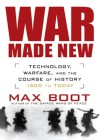War Made New: Technology, Warfare and the Course of History 1500 to Today
Written by: Max Boot,
Gotham Books, New York, 2006,
ISBN: 978-1592402229, 624 pp.
Reviewed by: Antony Trentini, Visiting Fellow, Defence and Security Applications Research Centre.
While it would seem, on the strength of the book’s title, that Max Boot would present an unbalanced and radical technological determinist argument with War Made New: Technology, Warfare and the Course of History 1500 to Today, he does not. Instead, Boot’s analysis of the impact of technology on warfare and history over the last five centuries is balanced, reasoned and well argued. His conclusions centre on several major themes that are consistently demonstrated by the many and varied historical examples he fields.
The first of these themes is the use of technology. Boot argues convincingly that, in explaining the victories of history, it was not that one side or the other had superior technology, but rather they had better ways of exploiting it. For example, both the Swedish and Imperial armies at the Battle of Breitenfeld had muskets, but the superior Swedish tactics and organisation allowed them to maximise their firepower. Accordingly, the Swedes won a crushing victory over their once-imposing foe. Several hundred years later, the German panzer forces, equipped with tanks inferior to their Allied counterparts, soundly defeated the French and British armies by utilising superior tactical and operational concepts to devastating effect. Boot amply demonstrates that, throughout history, military technology has been only as good as the forces employing it.
Boot also shows that military technological advances must take place on a broad front; innovations must occur in more things than weapons themselves. The Japanese carrier-borne strike on Pearl Harbour, which may seem a regular operation today, was almost unheard of at the time. By taking available technologies, and combining them in innovative ways, the Japanese were able to achieve total surprise and tactical success. Similarly, the innovative combination of heavy cannon, agile galleons and new tactical and operational techniques by the British fleet allowed them to confront the much stronger Spanish Armada. As Boot writes, ‘a crucial element of the English success was their commander’s ability to learn on the fly, make adjustments and attempt new tactics. The Spanish paid a heavy price for their lack of equal flexibility’.
Finally, Boot makes a critical point about ‘Revolutions in Military Affairs’, or RMAs: they are only revolutions when they cause a major change in society more generally, and not only the military. The gunpowder age forced states to adopt modern bureaucracies, standing armies and rational models of organisation. The first Industrial Revolution led states to raise mass armies, which necessitated the mobilisation of their entire populations and economies. The second Industrial Revolution required the systematic application of a state’s intellectual resources, as well as their populations and economies, to the war effort: in the Second World War, the radio, radar, computer, and atomic bomb were all perfected or developed for war. This leaves the reader with an interesting question: does the current RMA actually qualify as a ‘revolution’? After all, the modern RMA is the application of civilian information management technologies to military operations, and not military operations impacting upon society. Boot himself stops short of claiming that the Information Revolution is an RMA, but he states that the effects on the military are so profound that it is likely. Overall, Boot maintains that, given our proximity to the Information Revolution, it is simply too early to tell. He goes on to argue that, even if the Information Revolution does turn out to be an RMA, it may not necessarily be Western countries that will benefit from it. Boot lists many telling examples of countries that invent technology, only to be the least able to adapt it: the Chinese and firearms and the British and the tank are two particularly illustrative examples of this point.
Boot has taken on the difficult task of compressing 500 years of history into 500-odd pages, and has done a good job. Boot’s narrative flows well, and makes for easy reading. His conclusions are clearly drawn. This is an appealing work that, while not the final word, serves as a useful examination of the broad relationship between emerging technology and the course of war.


